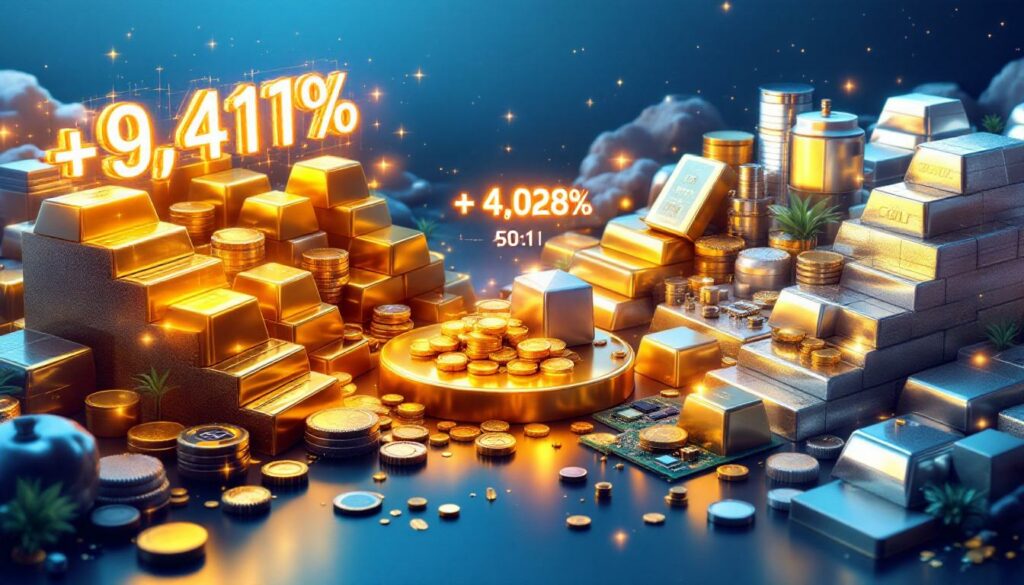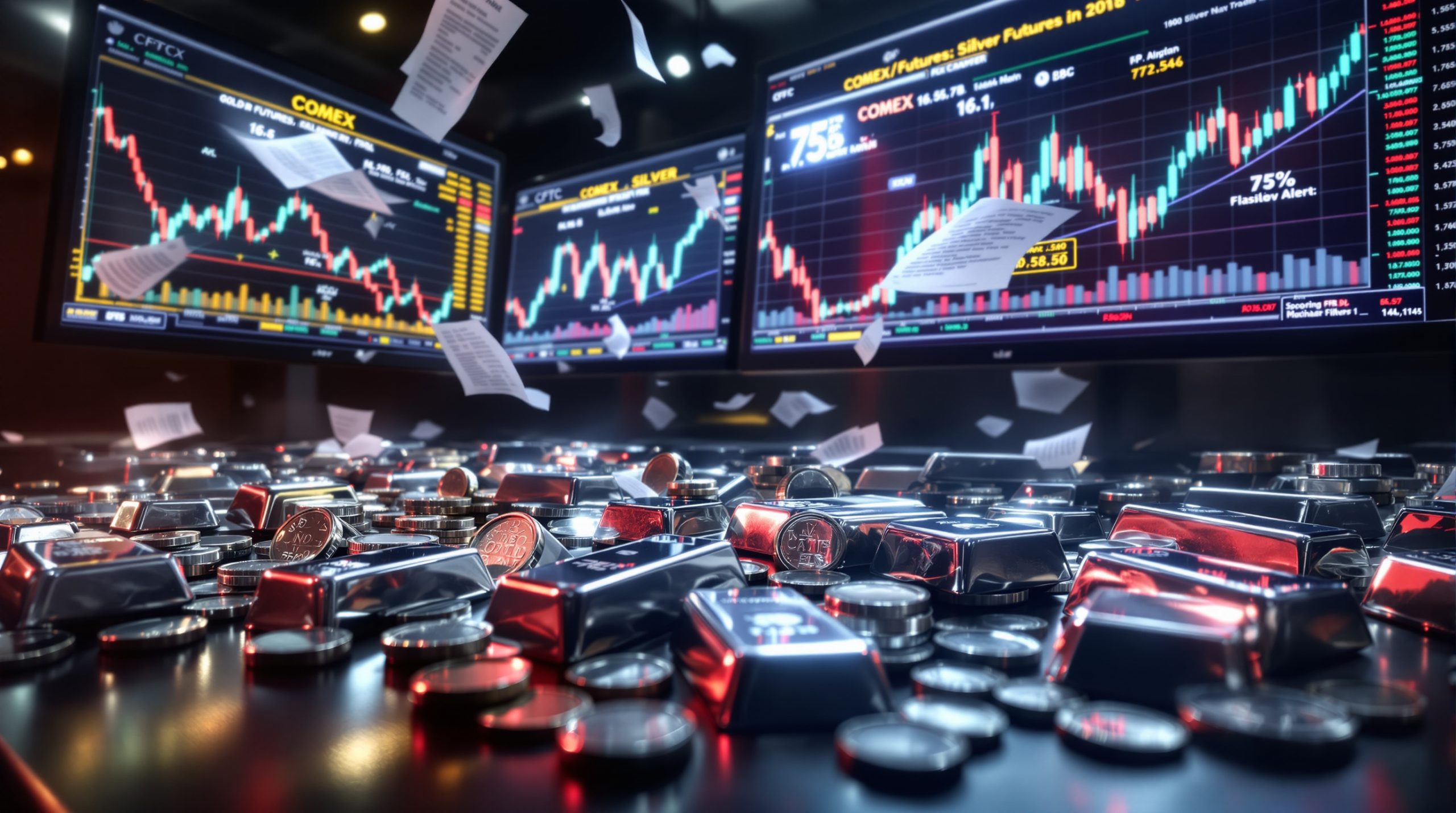How Gold and Silver Compare as Investments Over Time
For centuries, gold and silver have captivated investors seeking to preserve wealth and hedge against economic uncertainty. Understanding how these precious metals perform relative to each other can help investors make more informed decisions about their portfolio allocation. This comprehensive analysis examines the historical performance patterns, market drivers, and investment considerations for both metals.
The Historical Performance of Gold vs. Silver
When examining precious metals as long-term investments, the cumulative growth figures tell a compelling story about their relative performance.
Cumulative Growth Since 1960
Both gold and silver have delivered impressive returns over the past six-plus decades, though at significantly different magnitudes:
| Metal | Cumulative Growth (1960-2025) |
|---|---|
| Gold | +9,419% |
| Silver | +4,028% |
These figures, based on data from TradingView as of July 16, 2025, reveal gold's substantial outperformance over the complete 65-year timeframe. However, this long-term view masks the fascinating performance cycles where each metal has taken turns leading.
Key Performance Metrics
While gold shows greater overall growth since 1960, silver demonstrates significantly higher volatility and more dramatic percentage gains during specific bull market periods.
Silver's volatility profile: Silver typically exhibits 1.5-2x the price volatility of gold during both uptrends and downtrends, making it both potentially more rewarding and more risky.
Market size impact: Gold's global market capitalization (approximately $15 trillion) dwarfs silver's ($150 billion), contributing to silver's higher price sensitivity to capital flows.
Performance cycles: Rather than moving in lockstep, these metals follow distinct but related cycles, with leadership changing hands during different economic environments.
What Drives Gold and Silver Price Movements?
Understanding the underlying factors that influence precious metals prices reveals why they don't always move in tandem.
Monetary Policy Influences
The abandonment of the gold standard in 1971 marked a pivotal moment for precious metals pricing, unleashing both metals from their government-mandated price controls.
The Bretton Woods collapse effect: When President Nixon closed the gold window, ending dollar convertibility to gold, both metals began their most dramatic bull markets in modern history:
"The shift to unbacked fiat currencies fundamentally altered the monetary landscape, transforming gold and silver from fixed-price commodities into floating monetary assets that could respond to inflation and currency debasement." — MiningVisuals.com, 2025
Central bank activity: Unlike silver, gold remains a significant central bank reserve asset, with global reserves reaching 36,700 tonnes in 2025—a 30-year high. This institutional demand provides gold with a substantial price floor that silver lacks.
Interest rate sensitivity: Both metals typically perform best during periods of negative real interest rates (when inflation exceeds nominal rates), though gold shows higher correlation to this metric than silver.
Economic Uncertainty Factors
During periods of economic instability, both metals typically experience increased demand, though the drivers behind each metal's performance differ significantly:
Gold's crisis response: During acute market stress (like March 2020), gold often initially falls with other assets as investors seek cash, before rebounding strongly as a safe haven.
Silver's economic sensitivity: Silver demonstrates higher correlation to economic growth metrics, typically lagging gold at the start of crises but potentially outperforming during recoveries.
Inflation hedging characteristics: Both metals have historically preserved purchasing power during inflationary environments, though their effectiveness varies by inflation type and economic context.
When Has Silver Outperformed Gold?
Silver's most dramatic outperformance has occurred during specific historical periods characterized by particular economic and monetary conditions.
The Post-Bretton Woods Era (1971-1980)
This period saw extraordinary growth for both metals, with silver dramatically outpacing gold:
| Metal | Performance (1971-1980) |
|---|---|
| Silver | +3,600% |
| Gold | +2,400% |
Why Silver Dominated
Several factors combined to create silver's perfect storm during this period:
Rampant inflation: U.S. inflation averaged 9.2% annually between 1974-1980, creating strong demand for inflation hedges.
The Hunt brothers' market influence: Texas billionaires Nelson Bunker Hunt and William Herbert Hunt attempted to corner the silver market in 1979-1980, accumulating an estimated 100 million ounces and driving prices to then-record levels.
Industrial demand growth: The 1970s saw expanding industrial applications for silver coinciding with investment demand, creating supply pressure from both sectors.
Silver's smaller market size: Silver's relatively tiny market made it more responsive to capital inflows than gold, amplifying its percentage gains.
The 21st Century Bull Market (2001-2011)
Following the dot-com crash and through the 2008 financial crisis recovery:
| Metal | Performance (2001-2011) |
|---|---|
| Silver | +1,126% |
| Gold | +660% |
Contributing Factors
Quantitative easing programs: The Federal Reserve's unprecedented monetary expansion following the 2008 crisis triggered inflation fears and currency debasement concerns.
Retail investor participation: The introduction of silver ETFs (like SLV in 2006) dramatically increased accessibility for retail investors, with holdings surging 48% year-over-year in 2010 alone.
Expanding industrial applications: Growing demand from solar panel manufacturing, which increased silver consumption by over 400% since 2000, created additional price pressure.
Supply constraints: Silver mine production struggled to keep pace with demand, with primary silver mines (where silver is the main product) representing only about 25% of global production.
When Has Gold Outperformed Silver?
While silver has shown more dramatic percentage gains during certain periods, gold has demonstrated superior performance during others, particularly in recent years.
Recent Market Dynamics (2018-2025)
The most recent major bull market has shown a reversal of the historical pattern:
| Metal | Performance (2018-2025) |
|---|---|
| Gold | +216% |
| Silver | +176% |
Reasons for Gold's Recent Dominance
Geopolitical tensions: Escalating global conflicts, including the Russia-Ukraine war and Middle East instability, have increased safe-haven demand favoring gold over silver.
Central bank purchasing: Gold buying by central banks reached multi-decade highs, with China, Russia, Turkey, and India leading acquisition programs that added significant demand not present for silver.
Institutional investor allocation shifts: Major institutional investors increased gold allocations as portfolio diversifiers, with gold ETF holdings growing 22% year-over-year in 2024 while silver ETF holdings remained relatively flat.
Post-pandemic monetary policy: The Federal Reserve's aggressive interest rate hikes to combat inflation historically impact silver more negatively than gold due to silver's industrial demand component.
What Is the Gold-to-Silver Ratio?
The gold-to-silver ratio represents one of the most watched metrics in precious metals markets, offering insights into relative valuation and potential trading opportunities.
Understanding the Relationship
The gold-silver ratio analysis indicates how many ounces of silver it takes to purchase one ounce of gold. This metric has fluctuated significantly throughout history and often signals potential investment opportunities.
"The gold-to-silver ratio serves as a barometer for relative value between the metals. Historically, extremes in this ratio have identified potential reversal points that technical traders can exploit." — MiningVisuals.com, 2025
Historical Ratio Ranges
The ratio has demonstrated clear cyclical patterns over different economic eras:
| Period | Average Ratio | Ratio Range |
|---|---|---|
| 1970s | 35:1 | 15:1 – 45:1 |
| 2000s | 60:1 | 45:1 – 80:1 |
| 2020s | 75:1 | 65:1 – 125:1 |
These widening ranges reflect structural changes in both markets, including silver's diminished monetary role and increased industrial applications.
Trading Implications
Many precious metals investors use the ratio to inform their allocation decisions:
Ratio extremes as signals: When the ratio reaches historical extremes (above 80:1), many investors view silver as undervalued relative to gold and shift allocations accordingly.
Mean reversion strategies: Trading strategies based on the ratio's tendency to revert toward its long-term average (around 55:1 since 1970) have shown statistical merit, though implementation requires patience and discipline.
Futures spread trading: Professional traders often express ratio views through spread positions between gold and silver futures contracts rather than physical metal.
Mining stock leverage: Companies with primary silver production often demonstrate higher beta to ratio shifts than the metals themselves, potentially offering amplified returns when the ratio narrows.
How Do Industrial Applications Impact Silver Prices?
Unlike gold, silver has substantial industrial demand that significantly influences its price dynamics and creates both opportunities and challenges for investors.
Dual-Nature of Silver Demand
Silver's price is pulled between its roles as both a precious metal and an industrial commodity:
Demand breakdown (2025):
- Industrial: 55% (including electronics, solar, automotive)
- Investment: 25% (physical bars/coins, ETFs)
- Jewelry/Silverware: 20%
This contrasts sharply with gold, where investment and jewelry represent over 85% of annual demand.
Key Industrial Uses
Silver's unique physical properties make it essential across multiple industries:
Solar energy: Photovoltaic cells require silver for conductivity, with PERC solar cells using approximately 15mg of silver per watt of capacity. The Silver Institute projects solar demand could consume 20% of global silver supply by 2030.
Electronics: Silver's unmatched electrical conductivity makes it critical in smartphones, tablets, and automotive electronics, contributing to approximately 3,100 tonnes of annual demand.
Medical applications: Silver's antimicrobial properties drive usage in medical devices, wound dressings, and hospital equipment—a sector growing at 9% annually.
Emerging technologies: Silver remains irreplaceable in 5G infrastructure, electric vehicles, and IoT devices, potentially creating new demand sources as these technologies expand.
Impact on Price Volatility
Silver's industrial component introduces unique price dynamics:
Economic sensitivity: Research indicates a 1% change in global GDP correlates with approximately 2.3% change in industrial silver demand, creating higher economic cycle sensitivity than gold.
Seasonal patterns: Silver often experiences seasonal demand fluctuations tied to manufacturing cycles, particularly in electronics and solar panel production.
Substitution risk: At high prices, manufacturers may seek alternatives or reduce silver content (thrifting), creating natural price resistance levels not present with gold.
Recycling economics: Unlike gold, much industrial silver ends up in landfills due to low concentration in end products, though this is changing as recovery technology improves.
Which Metal Offers Better Inflation Protection?
Both metals have served as inflation hedges throughout history, but their effectiveness varies across different inflationary environments.
Historical Inflation Hedge Performance
The effectiveness of gold and silver as inflation hedges depends significantly on the inflation regime and accompanying economic conditions:
Stagflation periods: During the 1970s stagflation (high inflation with low growth), both metals delivered exceptional returns, with silver outperforming.
Modest inflation with growth: In periods of moderate inflation accompanied by economic growth, silver often outperforms due to combined industrial and investment demand.
Deflation risk periods: Gold typically outperforms silver during deflationary scares, as seen during the 2008 financial crisis and early COVID-19 pandemic.
Comparison During High Inflation Periods
Performance during specific high-inflation periods reveals how each metal responds to different inflation scenarios:
| Period | Annual Inflation Rate | Gold Performance | Silver Performance |
|---|---|---|---|
| 1974-1980 | 9.2% average | +721% | +1,064% |
| 2007-2011 | 2.3% average | +144% | +218% |
| 2020-2025 | 3.8% average | +87% | +62% |
These figures demonstrate that during the extreme inflation of the 1970s and the moderate inflation following the 2008 crisis, silver outperformed gold. However, during the most recent inflationary period (2020-2025), gold has shown superior performance, likely due to its stronger appeal during geopolitical uncertainty.
How Do Storage Costs Compare?
The physical characteristics of gold and silver create significant practical differences for investors considering physical ownership.
Physical Storage Considerations
Silver's lower value-to-volume ratio creates practical storage challenges that investors should consider:
| Metal | $100,000 Investment | Approximate Weight | Storage Implications |
|---|---|---|---|
| Gold | ~1.5 kg (3.3 lbs) | Small safe adequate | Lower relative costs |
| Silver | ~120 kg (265 lbs) | Requires significant space | Higher relative costs |
Storage cost impact: Professional storage for silver typically costs 0.5-0.8% annually versus 0.3-0.5% for gold, creating a higher carrying cost that compounds over time.
Insurance considerations: Home storage of significant silver holdings may increase insurance premiums or require special riders due to both value and theft risk.
Transportation logistics: Moving physical silver requires consideration of weight, security, and potential freight costs that are minimal with equivalent gold values.
Liquidity differences: Smaller dealers may have cash flow or storage constraints that limit their ability to purchase large silver positions, potentially affecting resale options.
What Are the Key Investment Vehicles?
Investors have multiple options for gaining exposure to precious metals, each with distinct advantages and considerations.
Physical Ownership Options
Direct ownership remains popular among precious metals investors:
Bullion coins and bars: Government-minted coins (American Eagles, Canadian Maple Leafs) and privately minted bars offer the most direct ownership form, though typically with premiums over spot prices (2-8% for gold, 8-15% for silver).
Allocated storage programs: Services like BullionVault and Money Metals Depository offer allocated ownership with professional storage, typically charging 0.3-0.8% annually.
Safe deposit boxes: While offering privacy, these lack insurance for contents and may be subject to bank holiday closures during financial crises.
Home storage solutions: From simple safes to specialized precious metals vaults, these options provide immediate access but with security considerations.
Market-Based Alternatives
For investors seeking precious metals exposure without physical possession:
Exchange-traded funds (ETFs): Funds like GLD, IAU (gold) and SLV, PSLV (silver) offer stock exchange liquidity and minimal tracking error, though with annual expense ratios (0.25-0.50%) and no direct redemption rights for most investors.
Mining company stocks: Companies like Newmont (gold) and Pan American Silver (silver) offer operational leverage to metal prices, potentially delivering amplified returns during bull markets, along with dividends not available from physical metals.
Royalty and streaming companies: Firms like Franco-Nevada and Wheaton Precious Metals provide exposure to multiple mining operations with reduced operational risk, though typically at premium valuations.
Futures and options contracts: These derivatives offer leverage and efficient tax treatment (60/40 long-term/short-term gains in the U.S.) but require specialized knowledge and involve counterparty risk.
How Should Investors Approach Gold and Silver Allocation?
Determining the optimal allocation between gold and silver requires careful consideration of investment objectives, risk tolerance, and market outlook.
Portfolio Considerations
When establishing a precious metals allocation strategy, investors should evaluate several key factors:
Risk tolerance assessment: Silver's higher volatility makes it better suited for investors comfortable with larger price swings and potential drawdowns.
Investment timeline: Shorter time horizons may favor gold's lower volatility, while longer timelines allow investors to potentially benefit from silver's higher cyclical upside.
Portfolio correlation benefits: Both metals offer diversification from traditional financial assets, with gold historically showing lower correlation to equities than silver.
Current market positioning: The gold-to-silver ratio provides context for relative valuation, potentially informing tactical allocation shifts based on historical patterns.
Diversification Strategies
Investors can implement several approaches to precious metals allocation:
Conservative approach: Higher gold allocation (e.g., 80% gold, 20% silver) reduces volatility while maintaining some exposure to silver's potential outperformance.
Aggressive approach: Higher silver allocation (e.g., 40% gold, 60% silver) increases both risk and potential return, especially appropriate during early-cycle economic expansions.
Ratio-based rebalancing: Systematically adjust allocations based on the gold-to-silver ratio, increasing silver exposure when the ratio is historically high and gold exposure when it's low.
Dollar-cost averaging: Regular purchases of both metals in fixed proportions can reduce timing risk and allow accumulation through price cycles.
FAQ: Common Questions About Gold and Silver Investing
Is silver more volatile than gold?
Yes, silver consistently demonstrates higher price volatility than gold. Over the past 50 years, silver has shown approximately 1.5-2x the standard deviation of returns compared to gold. This volatility stems from silver's smaller market size, industrial demand component, and higher retail investor participation. While this volatility creates greater profit potential during bull markets, it also means deeper drawdowns during corrections.
Which is better for small investors?
Silver offers advantages for investors starting
Want to Spot the Next Major Mineral Discovery?
Discovery Alert's proprietary Discovery IQ model delivers real-time alerts on significant ASX mineral discoveries, instantly empowering subscribers to identify actionable opportunities ahead of the broader market. Understand why historic discoveries can generate substantial returns by visiting Discovery Alert's dedicated discoveries page. Begin your 30-day free trial today to position yourself ahead of the market.




